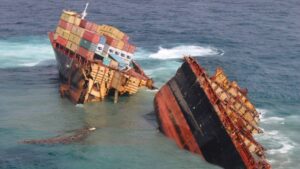
(www.MaritimeCyprus.com) On October 5, 2011, an oil spill began off the coast of New Zealand that would become what many describe as the country's worst maritime environmental disaster.
When the MV Rena container ship (owned by Greek shipping company Costamare Inc.) ran aground on Astrolabe Reef 12 miles off the coast of New Zealand's North Island, a leak of fuel and diesel oil eventually spilled 93,000 gallons into the Bay of Plenty.
The disaster killed thousands of birds, with some death estimates as high as 20,000. Some species, such as the New Zealand dotterels, were preemptively captured and sequestered for their own survival. Some dotterels weren't so lucky; a number died of respiratory infections due to the spill.
Many local residents disregarded orders from the goverment and began to organize cleanup efforts. Five thousand volunteers were involved in cleaning the bay's shoreline.
Although signs of the ship splitting in two were reported as early as Oct. 12, the Rena eventually broke apart in January. More oil was found leaking from the wreckage, but it is unknown how much more leaked into the ocean. One slick from this secondary spill stretched over one square kilometer of water.
As early spring storms lashed against the wreckage, oil continued to slowly leak from the hull. Much of the wreckage continued to be collected eight six months after the crash.
On May 25, Captain Mauro Balomaga and his navigation officer, Leonil Relon, were found guilty of operating the ship in a dangerous manner as well as changing navigation records in order to mislead investigators. They were both sentenced to seven months.
Storyline:
The Liberian-registered container ship Rena had left the New Zealand port of Napier at 1020 on 4 October 2011 and was bound for the New Zealand port of Tauranga. The master had given an estimated time of arrival at the Tauranga pilot station of 0300 the next day. The master calculated the estimated time of arrival by dividing the distance to go by the Rena's normal service speed. The calculation did not account for the unfavourable currents that normally prevailed down that stretch of coastline.
After departure from Napier the master learned from notes on the chart of the unfavourable currents. He then authorised the watchkeepers to deviate from the planned course lines on the chart to shorten the distance, and to search for the least unfavourable currents.
The Rena's second mate took over the watch shortly after midnight on 4 October. He calculated that the Rena would arrive at the port of Tauranga pilot station at 0300 at the ship's then current speed. Times for ships entering and leaving Tauranga Harbour are limited by the depth of water and the strength of the tidal currents in the entrance channel. Tauranga Harbour Control informed the second mate that the latest time the Rena could take the harbour pilot on board was 0300.
The planned course to the Tauranga pilot station was to pass two nautical miles north of Astrolabe Reef before making the final adjustment in course to the pilot station. The second mate decided to reduce the two miles to one mile in order to save time. The second mate then made a series of small course adjustments towards Astrolabe Reef to make the shortcut. In doing so he altered the course 5 degrees past the required track and did not make an allowance for any compass error or sideways "drift", and as a consequence the Rena was making a ground track directly for Astrolabe Reef. Meanwhile the master had been woken and arrived on the bridge to prepare for arrival at the port.
The master and second mate discussed preparations for arrival at the pilot station. The master then assumed control of the ship, having received virtually no information on where the ship was, where it was heading, and what immediate dangers to navigation he needed to consider.
During this period of handover no-one was monitoring the position of the ship. At 0214 the Rena ran aground at full speed on Astrolabe Reef. The ship remained stuck fast on the reef and in the ensuing months it broke in two. The aft section moved off the reef and sank. About 200 tonnes of heavy fuel oil were lost to the sea. A substantial amount of cargo in the containers was lost. The vessel became a total loss on 11 October 2011.
The Transport Accident Investigation Commission (the Commission) concluded that the Rena grounding was not in any way attributable to the malfunction of any on-board machinery or equipment, including on-board navigational equipment.
Factors that directly contributed to the grounding included the crew:
- not following standard good practice for planning and executing the voyage
- not following standard good practice for navigation watchkeeping
- not following standard good practice when taking over control of the ship.
Safety issues that the Commission identified in the wider context included:
|
The report also discusses two other considerations that were raised during the inquiry - whether there is a need for ship routing in some form around the New Zealand coast, and how far maritime authorities should go in marking hazards to navigation such as Astrolabe Reef.
The Commission identified two issues: first, with regard to shipping, there is insufficient data being collected to make a meaningful analysis of shipping movements around the New Zealand coast; and secondly, with regard to marking hazards, a new type of "virtual aid to navigation" is being used for marking hazards to navigation before this system has been fully tested and endorsed by the International Association of Marine Aids to Navigation and Lighthouse Authorities.
The Commission made recommendations to:
|
The key lessons learnt from the inquiry into this accident were:
|
Further details may be found by reading the FINAL report here
Watch the documentary from Euronews below:



















